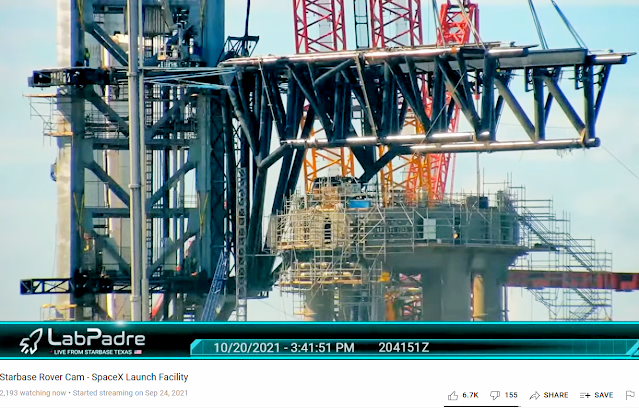As mentioned last Friday, SpaceX Boca Chica has started doing tests of the giant metal "chopsticks" that are on the Orbital Launch Integration Tower (OLIT), expanding the testing envelope a little at a time through today. The combination of the functional chopsticks and the OLIT is referred to as Mechazilla, in case you forgot. They're pictured here on October 20, and details have since changed, but look roughly like this:
As Eric Ralph at Teslarati points out, the testing started out on January 4th with simple movements where the chopsticks were sitting - just over the launch mount (much like the above picture).
Four days later, SpaceX performed a variation on the first round of tests, again slowly lifting the assembly up the side of the launch tower and opening and closing the arms. The most notable difference was the addition of several tandem swing tests, which hinted at more applied tests that were soon to come. SpaceX also performed some basic tests with a third Starship fueling arm higher up on the tower, very slowly swinging it towards where Starship would be standing.
On Sunday afternoon, a third major round of testing kicked off. This set of tests was considerably more focused than the prior two, suggesting that it was more of a simulation of the main purpose of the arms.
Sunday,
the chopsticks were raised up the OLIT as high as they're required to go
and several of the required motions were tested. At this height, the Chopsticks can place a Starship on top of the
Super Heavy booster.
There are animations of what this could look like on Twitter, but nothing that has any endorsements from Elon Musk. This one seems realistic and complete.
Ultimately, the tower seemed to complete the simulation without any showstopping issues. Up next, it’s possible that SpaceX will add weights to the simulator bar to fully simulate the 100-200 ton masses of Starship and Super Heavy. Eventually, SpaceX may also use Starship S20 and Super Heavy B4 to fully qualify the arms by actually lifting, stacking, and removing both stages.
Remember: it was almost exactly a year ago that we first heard that SpaceX was, at least metaphorically, saying it's too easy to land an orbital class booster on a figurative postage stamp 400 miles from any landmark so they were going to fly the boosters back to the launch site and snatch them out of mid-air. There are good reasons to want to do this; the biggest are that it saves weight on vehicle which translates to bigger payloads, and it saves the expense of sending drone ships and infrastructure down range. Super Heavy has an advantage over Falcon 9 (at least, theoretically) in that Falcon 9 can't hover. It's so light at landing that a single engine can't throttle back far enough to hover, which means the flight computers have to get the descent velocity down to zero just as the booster touches down. A Super Heavy will be able to hover. I suspect we'll see that in the early tests.


No comments:
Post a Comment